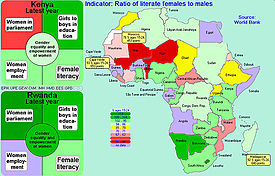- Dashboard (management information systems)
-
In management information systems, a dashboard is an executive information system user interface that (similar to an automobile's dashboard) is designed to be easy to read. For example, a product might obtain information from the local operating system in a computer, from one or more applications that may be running, and from one or more remote sites on the Web and present it as though it all came from the same source.[1] Dashboards should not be confused with scorecards.
Contents
Types of dashboards
Digital dashboards may be laid out to track the flows inherent in the business processes that they monitor. Graphically, users may see the high-level processes and then drill down into low level data. This level of detail is often buried deep within the corporate enterprise and otherwise unavailable to the senior executives.
Three main types of digital dashboard dominate the market today: stand alone software applications, web-browser based applications, and desktop applications also known as desktop widgets. The last are driven by a widget engine.
Specialized dashboards may track all corporate functions. Examples include human resources, recruiting, sales, operations, security, information technology, project management, customer relationship management and many more departmental dashboards.
Digital dashboard projects involve business units as the driver and the information technology department as the enabler. The success of digital dashboard projects often depends on the metrics that were chosen for monitoring. Key performance indicators, balanced scorecards, and sales performance figures are some of the content appropriate on business dashboards.
Interface design styles
Like a car's dashboard (or control panel), a software dashboard provides decision makers with the input necessary to "drive" the business. Thus, a graphical user interface may be designed to display summaries, graphics (e.g., bar charts, pie charts, bullet graphs, "sparklines," etc.), and gauges (with colors similar to traffic lights) in a portal-like framework to highlight important information.
History
The idea of digital dashboards followed the study of decision support systems in the 1970s. With the surge of the web in the late 1990s, digital dashboards as we know them today began appearing. Many systems were developed in-house by organizations to consolidate and display data already being gathered in various information systems throughout the organization. Today, digital dashboard technology is available "out-of-the-box" from many software providers. Some companies however continue to do in-house development and maintenance of dashboard applications. For example, GE Aviation has developed a proprietary software/portal called "Digital Cockpit" to monitor the trends in aircraft spare parts business.
In the late 1990s, Microsoft promoted a concept known as the Digital Nervous System and "digital dashboards" were described as being one leg of that concept.[2]
Benefits of digital dashboards
Digital dashboards allow managers to monitor the contribution of the various departments in their organization. To gauge exactly how well an organization is performing overall, digital dashboards allow you to capture and report specific data points from each department within the organization, thus providing a "snapshot" of performance.
Benefits[citation needed] of using digital dashboards include:
- Visual presentation of performance measures
- Ability to identify and correct negative trends
- Measure efficiencies/inefficiencies
- Ability to generate detailed reports showing new trends
- Ability to make more informed decisions based on collected business intelligence
- Align strategies and organizational goals
- Saves time compared to running multiple reports
- Gain total visibility of all systems instantly
- Quick identification of data outliers and correlations
See also
- Dashboard (disambiguation)
- Dashboard (business)
- Business activity monitoring
- Business intelligence
- Complex event processing
- Corporate performance management
- Dashboard of Sustainability
- Data mining
- Data Presentation Architecture
- Enterprise manufacturing intelligence
- Event stream processing
- Information graphics
- Information design
- Scientific visualization
- Spreadsheet
- Visualization (graphic)
References
- Notes
- ^ Dictionary definition of dashboards, contributed by Matt Sorenson, SearchCIO.com, 25 February 2002. Retrieved: 9 February 2008.
- ^ "Microsoft refines Digital Dashboard concept". http://www.kmworld.com/Articles/News/Breaking-News/Microsoft-refines-Digital-Dashboard-concept--12189.aspx. Retrieved 2009-06-09.
- Bibliography
- Few, Stephen (2006). Information Dashboard Design. O'Reilly. ISBN 978-0-596-10016-2.
- Eckerson, Wayne W (2006). Performance Dashboards: Measuring, Monitoring, and Managing Your Business. John Wiley & Sons. ISBN 978-0471778639.
Categories:
Wikimedia Foundation. 2010.

